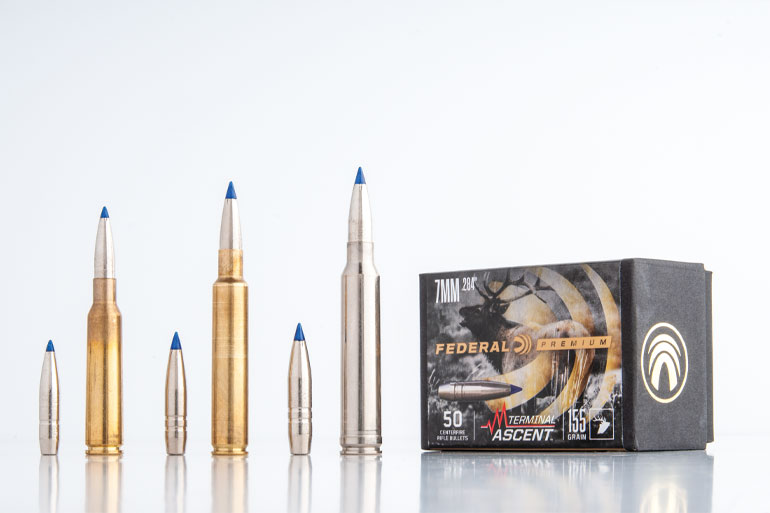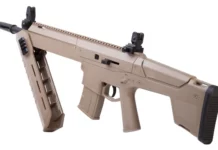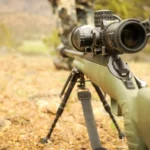
An evolution of the legendary Trophy Bonded Bear Claw, Federal’s new Terminal Ascent bullet is a cutting-edge projectile possessing excellent aerodynamics and outstanding accuracy. It offers arguably the most versatile on-impact performance characteristics of all big game hunting bullets.
The short video below shows a hunter taking a Texas aoudad at 600 yards with Federal Custom Shop Rifle Ammo loaded with a Terminal Ascent bullet. Other equipment used: Mesa Precision Arms Rifle, Swarovski Z8 Scope, Silencer Central Banish 30 Suppressor.
Along with factory-loaded ammo for myriad popular cartridges, Federal introduced the Terminal Ascent in component-bullet form. Initial calibers and weights include a 130-grain 6.5mm version with a G1 ballistic coefficient of .532, 136-grain .277 (BC.493), 155-grain 7mm (.586), 175-grain .308 (.520) and a 200-grain .308 (.608).
The Terminal Ascent is basically the fourth generation of Bear Claw-type bullets. Following the original Bear Claw was the composite-tipped, boattailed Trophy Bonded Tip big game bullet optimized for all-around use on deer- to moose-size game.
Third came the Edge TLR, which provided excellent aerodynamics and on-impact performance, but Federal felt it lacked the extraordinary accuracy demanded by today’s extended-range hunters.
Two years of R&D have resulted in the Terminal Ascent, a bullet that shares the ideal impact performance of the Edge TLR and regularly shoots 0.6-inch, 10-shot, 100-yard groups.
Like the Bear Claw, the design features a rear portion of solid copper and a lead front core bonded to the jacket. As a result, no matter how fast it is driven and how close an animal, the Terminal Ascent won’t “grenade” on impact. A good mushroom shape with a generous shank will create a large-diameter wound channel and drive deep—no matter how much heavy bone and dense muscle it encounters.
A boattail enables air to flow around the rear profile with minimum friction and cavitation. A sophisticated heat-resistant, hollow composite tip with a sleek profile further enhances aerodynamics and provides an unparalleled on-impact expansion mechanism.
This composite tip is heat resistant, so it doesn’t erode and suffer reduced, unpredictable aerodynamics like common Delrin polymer may when high-BC projectiles are fired from extreme-velocity cartridges.
Because of the hollow composite tip, which collapses inward on impact and exposes the massive hollow nose of the main projectile, the Terminal Ascent design provides reliable expansion at velocities as low as 1,500 fps—and in many versions 1,400 fps. This means that even when impacting at long range, your bullet will expand reliably and kill cleanly.
To test how easy it is to obtain good handload results with the Terminal Ascent, I assembled 10-round batches for three different cartridges, using an educated guess to pick propellant types and charge weights.
For my Ruger M77 Hawkeye African, I loaded the 130-grain 6.5mm version over 47 grains of Reloder 16 in once-fired Lapua 6.5×55 cases. For the 155-grain 7mm, I loaded a test batch for my .280 Ackley Improved Kimber Mountain Ascent, charging Nosler brass with 59 grains of H4831sc. I loaded the 200-grain .30 caliber version for my Kimber 8400 .300 Win. Mag., charging once-fired, nickel-plated Federal cases with 70 grains of H4831sc.
An all cases I primed with Federal Gold Medal primers. Before seating the Terminal Ascent bullets, I contacted Federal’s tech guru Jared Kutney for some seating-depth advice.
“Terminal Ascent bullets have a secant ogive—some more noticeable than others—but in contrast to standard secant ogive bullets, they do like a little jump. We recommend starting with .050 to .075 inch of jump and adjusting from there. We have found that .060 inch works well for the 6.5mm and 7mm bullets, specifically.”
Following his suggestions but wishing to mix it up a little, I seated bullets in the 6.5×55 test batch .060 inch off the rifling leade but seated projectiles in the .280 Ackley Improved and the .300 Win. Mag. ammo to .050 off the leade.
Three consecutive three-shot 100-yard groups averaged 0.69 inch out of the .300 Win. Mag. Velocity averaged 2,842 fps with a standard deviation of 13 fps. The Ruger 6.5×55 produced superb accuracy as well, averaging 0.77-inch groups for a series of three consecutive three-shot groups at 100 yards. Velocity averaged 3,029 fps with a standard deviation of eight fps.
Finally, I tested the 155-grain 7mm Terminal Ascent in the lightweight Kimber. It has a spaghetti-thin barrel, and it will shoot sub m.o.a. with ammo it likes, but it takes considerably more tuning than heavier rifles.
My handload did not produce sub-m.o.a. accuracy—averaging 1.23 m.o.a. for three three-shot groups—but standard deviation was just 4.6 fps. Average speed was 3,000 fps.
So two out of three of the rifles tested produced sub-m.o.a. accuracy with the first Terminal Ascent handloads attempted—and that was on a day with winds gusting to 15 mph. I’d say that’s downright impressive.
As for the rifle that didn’t, I’m going to work with it. The 155-grain 7mm Terminal Ascent bullet is theoretically perfectly balanced for the .280 Ackley cartridge, and I’m determined to find an accurate load. Judging by the easy accuracy provided by the 6.5mm and .30 caliber versions, I suspect it won’t be difficult.
One other element of the Terminal Ascent bullet line intrigued me. I’m a big fan of the Trophy Bonded Tip bullet and had excellent luck using the Edge TLR in Africa, but I wanted to know more about the AccuChannel grooves around the Terminal Ascent’s shank.
“Solid shank bullets benefit from grooves from a dispersion standpoint,” he said. “Our leading theory is that it makes the bullet more malleable by creating a void into which bullet material can displace when engaging the rifling. The effect is a reduced magnitude of vibration applied to the barrel, and therefore, by way of reduced harmonic reaction of the barrel, a more consistent launch vector from shot to shot.”
There is a drawback, though. “The downside of grooves is the added drag they impart to the bullet in flight,” Kutney said.
However, all grooves are not created equal, and good engineers can minimize adverse effects.
“The AccuChannel provides a smoother geometry from a fluid flow standpoint so as to minimize the drag penalty of each groove,” Kutney said.
How much BC reduction are we talking about? Not much. Comparing the aerodynamics listed for equal-weight Edge TLR and the Terminal Ascent, the more accurate newer version gives up just 1.5 to 4 percent of BC.
I’ve taken a number of animals with Trophy Bonded Bear Claws, Trophy Bonded Tips and Edge TLRs. In every case, terminal performance has been textbook perfect.
Because the Terminal Ascent shares the construction characteristics of its predecessors and adds an unprecedented level of accuracy, it will undoubtedly provide excellent, dependable performance in the field.











































